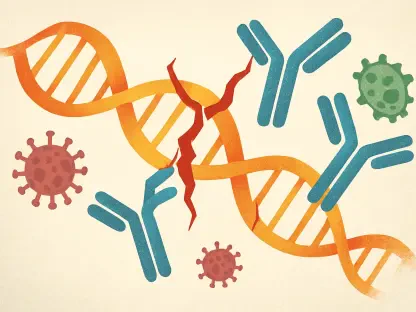In a significant leap forward for prostate cancer research, a recent study published in Nature Genetics on November 5 has spotlighted PTGES3 (Prostaglandin E Synthase 3) as a pivotal regulator of the androgen receptor (AR), a protein deeply implicated in the disease’s progression. Conducted by scientists from the Arc Institute, University of California, San Francisco (UCSF), and Fred Hutchinson Cancer Center, this research challenges the traditional understanding of PTGES3 as merely an enzyme or chaperone, revealing its critical role in driving aggressive, treatment-resistant forms of prostate cancer. With resistance to current hormone therapies posing a major hurdle for countless patients, this discovery introduces a promising new angle for therapeutic intervention. The urgent need for innovative approaches to combat this widespread cancer, which affects millions globally, underscores the importance of such findings. This breakthrough not only reshapes scientific perspectives but also ignites hope for more effective treatments in the face of persistent challenges.
Redefining a Protein’s Purpose
The conventional view of PTGES3 as one of several enzymes tied to prostaglandin synthesis has been dramatically overturned by this latest research. Instead, the study positions PTGES3 as a dual-function regulator of the androgen receptor in prostate cancer cells, playing a far more consequential role than previously imagined. Within the cytoplasm, it acts to stabilize AR, preventing its breakdown and ensuring its availability. Meanwhile, in the nucleus, PTGES3 enhances AR’s capacity to bind to DNA and activate genes that propel tumor growth. This dual mechanism amplifies the protein’s impact on cancer progression, marking it as a central player rather than a peripheral component. Such a redefinition shifts the focus toward understanding how seemingly secondary proteins can wield outsized influence in disease contexts, prompting a reevaluation of long-held assumptions in cancer biology.
This revelation about PTGES3’s role carries profound implications for how prostate cancer’s molecular drivers are perceived. Unlike its earlier classification, which limited its relevance to enzymatic activity, the newfound understanding highlights its direct involvement in sustaining the androgen receptor’s oncogenic potential. The study’s detailed exploration shows that by supporting AR at multiple levels, PTGES3 contributes significantly to the aggressive nature of treatment-resistant tumors. This insight challenges researchers to look beyond traditional targets and consider the broader network of regulators that enable cancer’s persistence. As a result, PTGES3 emerges not just as a bystander but as a critical factor that could redefine therapeutic strategies, emphasizing the need to address these upstream influencers in the fight against advanced stages of the disease.
Harnessing Advanced Research Techniques
The path to uncovering PTGES3’s unexpected role was paved by cutting-edge CRISPR screening methods, which allowed researchers to delve into the intricate workings of prostate cancer cells with unprecedented precision. By tagging the androgen receptor with a fluorescent marker, the team could track its levels in real time within highly aggressive cell lines. Through genome-wide CRISPR screens, they methodically deactivated various genes to pinpoint those essential for maintaining AR stability. This unbiased, quantitative approach not only reaffirmed known AR regulators but also spotlighted PTGES3 as a top candidate, a finding that might have otherwise remained hidden. Such innovative technology underscores the transformative potential of modern genetic tools in revealing critical biological insights.
Beyond confirming PTGES3’s significance, the use of CRISPR technology in this study exemplifies a broader shift in cancer research toward systematic, data-driven discovery. The ability to screen thousands of genes simultaneously and observe real-time effects offers a powerful means to identify novel targets that traditional methods might overlook. This approach’s success in highlighting PTGES3’s role demonstrates its reliability and versatility, potentially setting a standard for future investigations into other cancer-driving proteins. Moreover, it illustrates how technological advancements can bridge gaps in understanding complex diseases, providing a clearer picture of the molecular interactions at play. As such, this research not only advances knowledge of prostate cancer but also showcases a methodological leap that could influence oncology studies at large.
Connecting Research to Real-World Impact
A compelling aspect of this study lies in its ability to link laboratory findings with tangible clinical relevance, particularly through the analysis of patient data. The research revealed that elevated PTGES3 expression correlates strongly with poorer outcomes among patients undergoing hormone therapy, suggesting a direct connection to treatment resistance. This observation points to PTGES3 as a potential biomarker for identifying individuals at higher risk of therapeutic failure, which could guide more personalized treatment plans. By establishing this association, the study underscores the importance of translating molecular discoveries into practical tools for patient care, addressing a critical gap in managing advanced prostate cancer.
Further reinforcing PTGES3’s therapeutic potential, preclinical experiments in mouse models provided striking evidence of its impact. When PTGES3 was suppressed, tumor growth slowed significantly, and androgen receptor levels within the tumors dropped, indicating a direct effect on cancer progression. These results offer a promising foundation for developing new interventions that target this protein, potentially circumventing the resistance mechanisms that undermine current therapies. Bridging the divide between experimental data and clinical application, these findings highlight how PTGES3 could become a focal point for innovative treatments. This dual validation from patient data and animal studies strengthens the case for pursuing PTGES3 as a viable target, paving the way for more effective strategies against aggressive forms of the disease.
Charting the Future of Cancer Treatment
The therapeutic implications of targeting PTGES3 are vast, offering a novel strategy to address the persistent challenge of treatment resistance in prostate cancer. Unlike previous efforts that concentrated on directly inhibiting the androgen receptor’s activity, this research advocates for disrupting upstream regulators like PTGES3 that control AR’s stability and function. Such an approach could provide a way to bypass the adaptive mechanisms tumors develop against existing hormone therapies, potentially leading to more durable responses. With resistance remaining a formidable barrier, this perspective introduces a fresh line of attack that could reshape the treatment landscape for patients with advanced disease.
Looking ahead, the research team is delving into the structural intricacies of PTGES3’s interactions with the androgen receptor, aiming to uncover specific points for therapeutic intervention. Efforts are underway to develop targeted therapies, possibly leveraging protein degradation strategies that have shown promise in other clinical contexts. This focus on designing precise inhibitors reflects a commitment to translating scientific insights into actionable solutions. As these investigations progress, the hope is to craft treatments that not only target PTGES3 effectively but also minimize off-target effects, enhancing patient outcomes. This forward-looking endeavor signals a potential turning point in managing treatment-resistant prostate cancer, emphasizing the importance of innovative targets in overcoming longstanding clinical hurdles.









